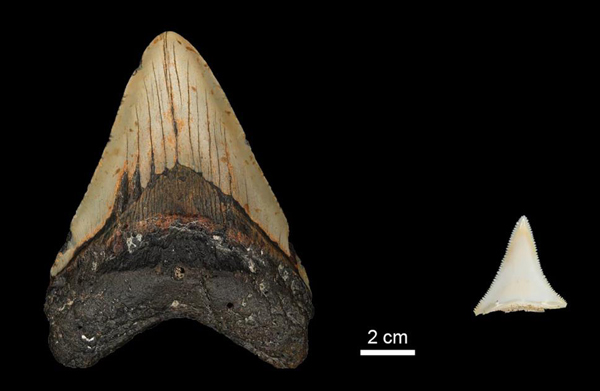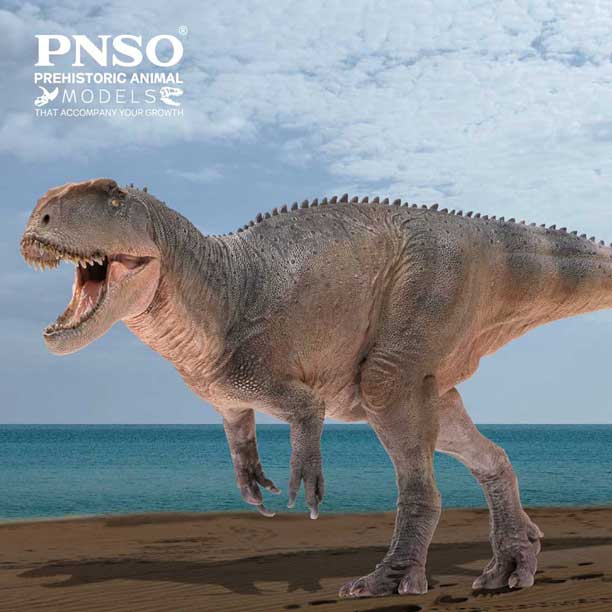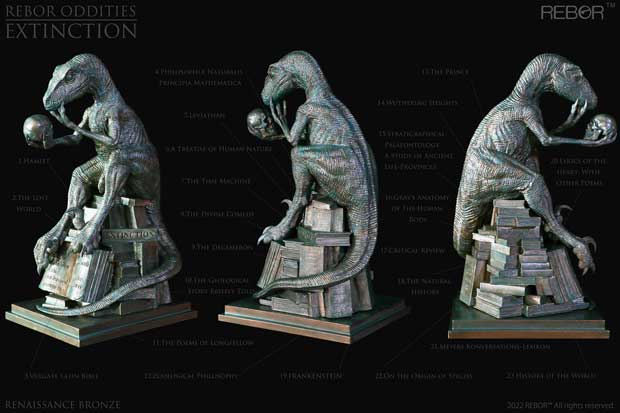Scientists are Fascinated with the Extinction of Megalodon
The extinction of Megalodon more appropriately termed Otodus megalodon, regarded as the largest hypercarnivorous shark that has ever existed has been the subject of numerous scientific papers. Newly published research suggests that competition for food and space with the Great White Shark (C. carcharias) and possibly other large taxa such as hypercarnivorous toothed whales could have played a role in the giant fish’s extinction.

The amazing, colourful sleeve artwork on the PNSO Megalodon figure. Several scientific papers have explored the potential reasons for the demise and extinction of Otodus megalodon – regarded as the largest hypercarnivorous shark known to science.
Zinc Isotope Analysis from Teeth
The diet of extinct animals can hold clues to their lifestyle, behaviour, evolution and ultimately their extinction. However, studying an animal’s diet after millions of years is difficult due to the poor preservation of chemical dietary indicators in organic material. An international team of scientists led by the Max Planck Institute for Evolutionary Anthropology (Leipzig, Germany), used a new technique, analysing zinc isotopes preserved in the mineralised tooth enamel to assess how far up the food chain Otodus megalodon was placed in comparison to the extant Great White Shark.

A tooth from extinct early Pliocene Otodus megalodon (left) compared with a tooth (right) from a modern Great White Shark (C. carcharias). Picture credit: Max Planck Institute for Evolutionary Anthropology.
Picture credit: Max Planck Institute for Evolutionary Anthropology
More Reliable than Nitrogen Isotope Analysis of Tooth Collagen
Nitrogen analysis of tooth collagen, a protein-based component of tooth dentine, has been used to establish the degree of animal matter consumed in a diet. However, in fossils collagen is generally not preserved so an analysis of zinc isotopes associated with the highly mineralised tooth enameloid may prove to be a more reliable indicator of the diet of long extinct animals.
Lead author of the study, published in “Nature Communications”, Dr Jeremy McCormack (Max Planck Institute for Evolutionary Anthropology) stated:
“On the timescales we investigate, collagen is not preserved, and traditional nitrogen isotope analysis is therefore not possible.”
The isotope ratios in O. megalodon teeth from the Pliocene were studied along with earlier Miocene “megatooth” taxa such as Otodus chubutensis. Modern contemporaneous shark species such as C. carcharias were analysed to provide a comparison. The researchers identified similar zinc isotope signatures in extinct as well as their modern analogous taxa.
Megalodon Occupied the Same Niche as Great White Sharks
The researchers concluded that super-sized sharks such as Otodus megalodon occupied the same niche in the ecosystem as the extant Great White Shark (Carcharodon carcharias). This suggests that when these two taxa were contemporaneous, they would have competed for the same resources.
This competition may have played a role in the demise and eventual extinction of Megalodon.

The CollectA 1:60 scale Megalodon shark model. The extinction of Otodus megalodon could have been caused by multiple, compounding environmental and ecological factors including climate change and thermal limitations, the collapse of prey populations and resource competition with Carcharodon carcharias.
The picture (above) shows a CollectA Deluxe Otodus megalodon shark model. It is a detailed prehistoric animal figure.
To view the range of CollectA Deluxe scale models: CollectA Deluxe Scale Models.
The extinction of Otodus megalodon could have had multiple causes. For example, environmental and ecological factors including climate change and dramatic cooling of the seas resulting in a restriction of the habitat of O. megalodon. In addition, the collapse of prey populations along with resource competition from Carcharodon carcharias could have put the prehistoric sharks under increasing pressure.
This study did not examine the potential impact on O. megalodon through competition from toothed whales (carnivorous odontocetes). If zinc isotope analysis proves to be a reliable methodology for analysing the diets of long extinct creatures, then this technique could be used to examine the impact of toothed whales on Megalodon populations.
Everything Dinosaur acknowledges the assistance of a media release from the Max Planck Institute for Evolutionary Anthropology in the compilation of this article.
The scientific paper: “Trophic position of Otodus megalodon and great white sharks through time revealed by zinc isotopes” by Jeremy McCormack, Michael L. Griffiths, Sora L. Kim, Kenshu Shimada, Molly Karnes, Harry Maisch, Sarah Pederzani, Nicolas Bourgon, Klervia Jaouen, Martin A. Becker, Niels Jöns, Guy Sisma-Ventura, Nicolas Straube, Jürgen Pollerspöck, Jean-Jacques Hublin, Robert A. Eagle and Thomas Tütken published in Nature Communications.
The award-winning Everything Dinosaur website: Prehistoric Animal Models and Toys.

























